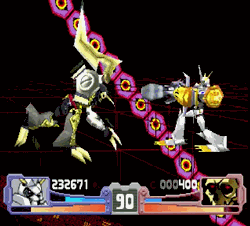 Ultimately, I would say the greatest barrier to people playing video games is video games.
Ultimately, I would say the greatest barrier to people playing video games is video games.
Video games are a unique entertainment medium. A book, whether it be comedy, adventure, or drama, still reads essentially the same way, cover to cover, and, barring some unique, potentially impeding linguistic flourishes, a 300 page novel about fancy suits and futuristic violence is going to go just as quickly as a similar sized novel on magical schoolchildren. Films require very little effort, even less with modern conveniences: just cue up any motion picture from the last century on your streaming service, and, two hours later, you’ve watched the movie. It doesn’t matter if it’s Citizen Kane or Clerks 2, there’s the same, nearly nonexistent entry barrier.
Video games, by contrast, can be ludicrously different from genre to genre. Consider World 1-1 of Super Mario Bros., the perennial platformer, versus crossing the same length of field in Paper Mario, an “action” RPG. In both, the exact same thing is happening: Mario is moving left to right, and jumping on goombas all the while; however the exact same action in two different games is conveyed radically differently, with numbers and dodging and possibly healing or death, and, more importantly, the time involved is drastically different, too. It’s up to the player to decide whether they enjoy the one-and-done “stomp” of Super Mario Bros. or the more technical and complex RPG back-and-forth battle of Paper Mario. A seemingly infinite number of Mario games boil down to “beat Bowser, save Peach”, but there’s scores of ways to “play” that same story with those same characters.
This creates an interesting conundrum for licensed games, aka games that import themselves from other mediums (television, movies, books [it’s happened!]). For instance, it seems the longer a franchise has existed, the more genres it has tried across video game history. The Simpsons, an animated series that has been on the air nearly as long as I’ve been alive (and thus, how could you not know what I’m talking about?), has seen NES platformers of dubious cohesion, a 90’s style arcade beat ‘em up, an eclectic 16-bit action game or two, 3-D platformers, a GTA-alike, and even a microtransaction-based cell phone adventure. Every single one of these games has been an attempt to adapt a series with a 20 year old, rigid sitcom formula featuring a group of characters that are most well-known for the variety of ways they sit on a couch. If I hadn’t seen Bart battle space mutants or Homer turn into a doughy sphere with my own eyes, I’d claim there was no way to adapt The Simpsons into the much more active video game medium, but I’m faced with two decades of evidence to the contrary.
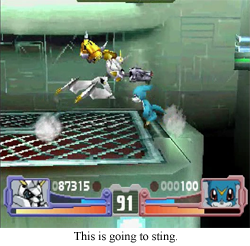 Not all franchises can be The Simpsons, and most video game adaptions are based on franchises that barely survive past the release of their tie-in material. I own a copy of The Last Action Hero for Sega Genesis, a Hulk PS2 game based on a movie that the Marvel Cinematic Universe seems to have disowned, and, the most ephemeral game of all, Water World for the Nintendo Virtual Boy. For franchises like that, you’re not going to get another chance to make another, different game if the first idea goes awry, so you’ve got to choose your genre carefully. What would better fit the next Schwarzenegger vehicle, a beat ‘em up or a shooter? Choose wisely, because someone is going to be mocking that choice a decade down the line on Youtube.
Not all franchises can be The Simpsons, and most video game adaptions are based on franchises that barely survive past the release of their tie-in material. I own a copy of The Last Action Hero for Sega Genesis, a Hulk PS2 game based on a movie that the Marvel Cinematic Universe seems to have disowned, and, the most ephemeral game of all, Water World for the Nintendo Virtual Boy. For franchises like that, you’re not going to get another chance to make another, different game if the first idea goes awry, so you’ve got to choose your genre carefully. What would better fit the next Schwarzenegger vehicle, a beat ‘em up or a shooter? Choose wisely, because someone is going to be mocking that choice a decade down the line on Youtube.
Make no mistake, that choice is now harder than it’s ever been. Have a franchise with a huge cast of characters, and everyone must be featured? Why not reduce all your hard hitting, action oozing stars to a tactical RPG, where you can boil everyone down to a series of numbers that only require four unique animations. Oh, but that will alienate the people who want something more visceral. How about a fighting game? People are just interested in the stars anyway, right? But now you need to actually balance the characters, assign them unique moves, and you’re still going to be stuck with a plot where best friends have to fight each other six times to compensate for the inevitably limited roster. How about we focus on that plot and go with a JRPG style game… but do you think a forty hour game would be a treat or threat to people who usually devote a half hour a week to the series? We could try an episodic Telltale-esque adventure game, as they seem to be closest to the average show’s format, but, unless it’s really unique, it’ll just wind up being “same as the source material, but every once in a while you have to find a key to advance the dialogue.” Can we just stick a bullet point for “like the show, but requires more work!” on the box? Screw it, let’s just remake Rampage, stick the main character’s head on one of the monsters, and claim it has “rogue-like elements”.
I am downright glad it’s not my job to make those decisions.
Digimon is, nowadays, remembered as the Go-Bots to Transformer’s Pokémon; however, you may be interested to know that Digimon started as a Tamagotchi rip-off. If you don’t know what I’m talking about, consider yourself lucky to have never lived through the horrible era of beeping keychains demanding to be fed, entertained, and cleaned at random intervals throughout the day. Digimon eventually digivolved into the 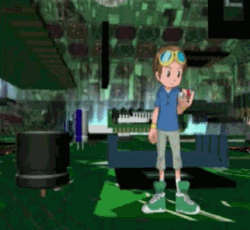 hard battling heroes that we know today the very moment Pokémon made it popular, though, so it was only natural that the franchise would follow the same JRPG path.
hard battling heroes that we know today the very moment Pokémon made it popular, though, so it was only natural that the franchise would follow the same JRPG path.
Only one problem: Digimon the show, which was very popular internationally, has about as much in common with Pokémon as it did with F • R • I • E • N • D • S.
I will always remember my friend Geoff commenting once, during Honors Physics, apropos of nothing, “Geez, Ash gave away his mankey this morning? I don’t think he’s ever going to catch all the pokémon.” To this day, there have been 897 (Christ!) episodes of the Pokémon animated series, and Ash currently has… let’s see here… carry the snorlax… yes, it appears Ash has 38 pokémon out of a possible 721. 5.2%. If my calculations are correct, this means that Ash will “catch ‘em all” right around the same time we colonize the sun. But that’s okay, because Pokémon isn’t that kind of show, it’s a show about a kid exploring his world and making friends and chatting up a different woman every season. Did you see the skirt on Dawn? It’s no wonder Ash has fallen behind on watching tall grass, if you catch my drift, wink wink, nudge nudge. Sorry, Geoff, but Ash is never going to satisfy the theme song.
Digimon the animated series, from first season to last, has always been a completely different animal. The Digimon world is one of constant conflict, where if there is not a clash between titans before the end of an episode, there’s something wrong. In fact, Digimon arguably follows a formula closer to Sentai than Pokémon: a group of teens are off and doing whatever they do, they encounter something strange, play around with it for twenty minutes, the situation escalates until there’s some creature the size of Godzilla stomping around, random teen’s digimon grows to jaeger-size, battle, 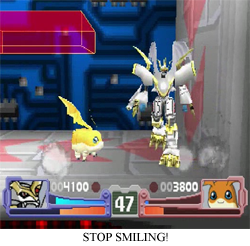 teen victory, and a lesson is learned, but the damage is irreversible. Digimon seasons have consistent arcs, and, like Dragonball Z, there is a constant escalation of power levels and super abilities and oh God how many different forms can Frieza cycle through in five minutes? Also, every Digimon series is a (mostly) self-contained arc, which is either a deliberate way to tell a story, or an excuse to reset all the power levels to zero so the next season has somewhere to go. All this adds up to a series that leans much more on combat than cooperation, and the constant battles are a high-energy, high-testosterone romp featuring actual monsters hurling planet-destroying fireballs against literal tidal waves.
teen victory, and a lesson is learned, but the damage is irreversible. Digimon seasons have consistent arcs, and, like Dragonball Z, there is a constant escalation of power levels and super abilities and oh God how many different forms can Frieza cycle through in five minutes? Also, every Digimon series is a (mostly) self-contained arc, which is either a deliberate way to tell a story, or an excuse to reset all the power levels to zero so the next season has somewhere to go. All this adds up to a series that leans much more on combat than cooperation, and the constant battles are a high-energy, high-testosterone romp featuring actual monsters hurling planet-destroying fireballs against literal tidal waves.
So maybe JRPG, the genre that defines “hurry up and wait”, wasn’t the best choice for the series. Digimon World was released in 1999 in Japan, saw a sequel the following year, and then garnered a card game, as was the style at the time. Finally, two years after the initial RPG release, there was Digimon Rumble Arena, a fighting game based on the series which, as an added bonus, actually featured characters from the popular television series, as opposed to a bunch of generic randos. Finally, the series that was closer to Mighty Morphin’ Power Rangers had a game to match.
Bad news? It was held back by the very thing that defined the series.
Digimon digivolve, and that’s the highpoint of Digimon. Unfortunately, right from the get-go, every medium but the television series misunderstood the appeal. In its Tamagotchi roots, it’s something akin to Pokémon evolving, basically just the lifecycle of the Digimon going forward. It’s mundane and about as exciting as grass growing. It’s even worse in the Digimon World (JRPG) series, as there, yes, it is the digimon getting stronger, 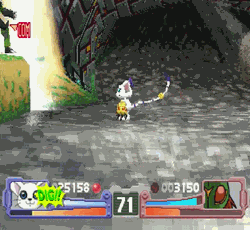 but also one step closer to the grave, as Digimon World digimon go through life/death cycles that mean your ultra level digimon is just three days away from retirement, and, then, ugh, you have to raise it back from nothing all over again. Digivolution thus becomes one part upgrade, one part threat. But in the animated series? Digivolution is always cool, because it’s Goku going Super Saiyan, it’s Tommy summoning the Dragonzord, it’s Wolverine announcing that he’s going to take his best shot, bub. It’s something that happens every episode five minutes before the credits roll because it’s the reason you’re watching, and the promise of new and more exciting digivolutions is the reason you’ll tune in next week.
but also one step closer to the grave, as Digimon World digimon go through life/death cycles that mean your ultra level digimon is just three days away from retirement, and, then, ugh, you have to raise it back from nothing all over again. Digivolution thus becomes one part upgrade, one part threat. But in the animated series? Digivolution is always cool, because it’s Goku going Super Saiyan, it’s Tommy summoning the Dragonzord, it’s Wolverine announcing that he’s going to take his best shot, bub. It’s something that happens every episode five minutes before the credits roll because it’s the reason you’re watching, and the promise of new and more exciting digivolutions is the reason you’ll tune in next week.
Digivolution sucks in Digimon Rumble Arena. As a sort of concession to the series, you have a digivolve “gauge” throughout every battle, akin to the “super meter” of Super Street Fighter 2 Turbo or alike, and when it fills, you can digivolve into a stronger digimon while the gauge slowly drains back down, de-digivolving your ‘mon when it’s back to empty. This should, in theory, be fun. In practice? There’s only three outcomes:
- Your opponent digivolved, but you haven’t. Since you’re at an extreme disadvantage, run for your life, and hope your opponent’s gauge depletes before you’re cornered.
- You digivolved, but your opponent hasn’t. Assuming your opponent isn’t an idiot, get ready to chase down your prey, and hope your digivolution holds its charge while you’re leaping all over the place. If you’re lucky, you’ll achieve a victory that seems about as earned as Mike Tyson punching out a squirrel.
- You both digivolved at about the same time! Yay! Now it’s exactly like the fight you were just having, but you’re both taller. Variety!
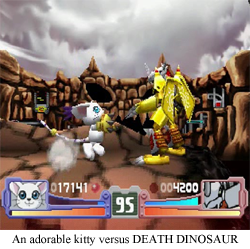 Couple this with arenas that are way too large for just two combatants, and you’ve got a fighting game that has all the urgency and excitement of an ice cream social. Digimon the Animated Series is all the action that can be crammed into a half hour, while Digimon Rumble Arena makes you sigh loudly when you realize every match is best out of three rounds. “Ugh, I have to do that again?” is not the kind of reaction anyone should ever have to a fire-breathing T-Rex battling a gatling gun toting giant rabbit.
Couple this with arenas that are way too large for just two combatants, and you’ve got a fighting game that has all the urgency and excitement of an ice cream social. Digimon the Animated Series is all the action that can be crammed into a half hour, while Digimon Rumble Arena makes you sigh loudly when you realize every match is best out of three rounds. “Ugh, I have to do that again?” is not the kind of reaction anyone should ever have to a fire-breathing T-Rex battling a gatling gun toting giant rabbit.
It’s unfortunate, but the series has not improved, either. I tried the most recent iteration of this franchise on the PS3, Digimon Not Smash Bros or whatever it’s called, and it had the exact same problem, possibly magnified by the fact that modern technology allows a hulking digivolved digimon to really tower over your average rookie. I don’t care how brave you are, when your opponent has four times your attack range, you’re going to run for the hills. Running isn’t fun in a fighting game, it’s just a waste of time.
This is what this whole chapter of the Digimon franchise is: a waste. Which is a shame, as the fighting genre is exactly what I would pick for Digimon. It seems like the best way to translate the constant, action-packed battles of the series, but, in practice, it leads to a game that does its absolute best to suck all the fun out of the room. Hey, you, get back here and let me use this super move I earned! Come on, be a pal and let me slaughter you!
So, children, want to get into the wide world of video games with your favorite franchise? Great! Your choices are a boring JRPG with absolutely no characters you’ll recognize aside from the franchise’s Pikachu, or a fighting game where you recognize everybody, but you’ll spend half of every match either cowering or chasing, but not actually fighting. What’s that? You’d rather just passively sit on the couch and watch the show you already unconditionally enjoy? Yeah, I can get that.
Gameplay is its own worst enemy sometimes.
FGC #54 Digimon Rumble Arena
- System: Sony Playstation. Huh. Isn’t this the generation that should have a Saturn port for every crappy fighting game?
- Number of Players: Two, even though the game seems to be built around four players, or at least more players than two to justify the fact that your fighters don’t “track” (face) each other at all times.
- Favorite Digimon: Patamon, which has always struck me as looking like an orange piece of bread with bat wings. It digivolves into an old school, “wrath of God” angel. I kinda enjoy the Digimon series for how completely bonkers its evolutionary lines are. There’s a cactus that turns into a fairy, for some reason, too.
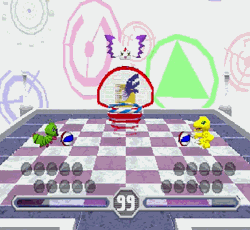 Time-Out: Oh, and this was released during that odd time in Fighting Game History when there was a mandatory stupid bonus game every few fights or so. This time, it’s a basketball battle between two digimon, because that makes as much sense as anything. Alternative suggestion: I wouldn’t have minded digivolving to kaiju size and taking out an entire car lot. I’d like to see Mike Haggar do that. No, I mean, seriously, I would.
Time-Out: Oh, and this was released during that odd time in Fighting Game History when there was a mandatory stupid bonus game every few fights or so. This time, it’s a basketball battle between two digimon, because that makes as much sense as anything. Alternative suggestion: I wouldn’t have minded digivolving to kaiju size and taking out an entire car lot. I’d like to see Mike Haggar do that. No, I mean, seriously, I would.- All told, you seem rather fond of Digimon: Well, yeah, it’s a series where its leaders wear the head wrappings of my people. I goggle-relate.
- Did you know? This game features characters from the first three seasons of Digimon. Digimon Seasons 1 & 2 share characters and a setting, but Season 3 was based in a universe where Digimon was simply a media franchise, and oh wow, now digimon are popping up in the “real” world. And then it turns out that the protagonist’s parents invented digimon and an entire universe of sentient computer data. You’d think that would have come up before the events of the show, but, hey, weird series.
- Would I play again? Nope. If there’s one thing this game does well, it’s that it makes you appreciate fighting games that are actually fun. We define darkness as the absence of light, and we define terrible fighting games as the absence of Ryu.
What’s Next? Random ROB has chosen… Eternal Darkness: Sanity’s Requiem. Yes, thanks to the holiday, I’m limiting ROB’s choices to anything that involves “spooky” content (and the previous two picks have, coincidentally, involved monsters) for the remainder of the week. So here’s a game meant to drive me iiiiiiiiinsane. Please look forward to it!
Can Digimon really be considered a ripoff of Tamagotchi when both were made by Bandai? It strikes me more as a marketing move to sell their LCD virtual pets to boys.
But speaking of monster-raising sims, if I’m gonna be raising something that’ll be near death’s door by the time it gets powerful, I’ll take Monster Rancher over Digimon World. At least it had the sense to have the life sim be the game instead of trying to shoehorn it into a standard jRPG experience.
Anyway, it’s super disappointing that there hasn’t been a good Digimon game, but I guess that’s par for the course with Bandai. For every Dragon Ball: Advanced Adventure, they release like 30 Dragon Powers.
Fun fact: the original version of this post descended into a lament on DBZ games kinda continually sucking…
[…] on the engine of the game proper. It’s fairly boring (actually, it kind of has the same issues as that Digimon game), everything feels kind of weightless because death traps and such only cause minor damage, and […]
[…] saw Pokémon Unite, where we are suddenly playing with “sliding” evolution like we’re playing a damn Digimon game. Nobody likes Digimon rules! Especially not […]